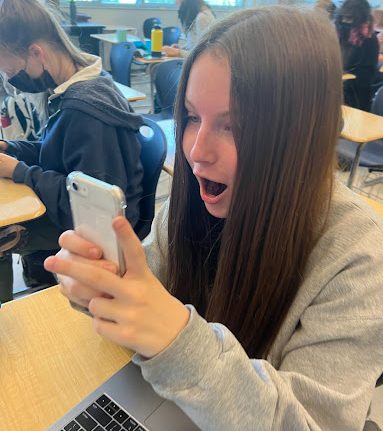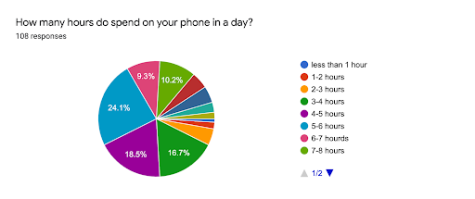The Screenagers of Chamblee: A Status Update

Photo courtesy of the Blue & Gold
A student looks in bewilderment at the magical world in her phone, featuring Blue & Gold staff writer Mallory Reid
April 21, 2022
Chances are, if you’re a teenager, you’re probably reading this on a screen right now. Did you see the link to this article on Instagram or did you get a notification it was posted? These little alerts often guide the course of our day, and our scrolling.
This spring, the Blue & Gold conducted a survey of 108 Chamblee students to find out their average screen time use. The students surveyed were evenly distributed between each grade level and surveyors were also asked to provide the app they used the most each day.
The majority of students at Chamblee have a daily screen time average of five to six hours. According to this survey, Chamblee teenagers spend one to two hours less on their phones compared to DataReportal’s report on the average American’s screen time. However, the range of screen time hours reported ranged widely from less than an hour to over eight hours. Like other addictions, it’s hard to know beforehand how susceptible someone may be to the thrill of their phone. Some students may have no problem setting it down while others find themselves consumed by its content.

Almost every single student that was surveyed had TikTok as their most used app. They spend hours on this never-ending video platform. TikTok has been downloaded over 200 million times in the United States, according to Wallaroo Media. The second most used app at Chamblee is Instagram. There are 159.75 million Instagram users in the United States, according to Statista.
Social media is not only a communication tool for students but also a way to update others on anything from current events to their own personal lives, and it can be a very toxic place.
“I think the worst parts about social media are that you are always comparing yourself to others and thinking you’re not good enough,” said Shea Fagan (‘25). “In general, social media does affect the way I see myself, but I’ve learned to somewhat ignore it, even though I may still feel jealous or not as good as other people.”
During quarantine, one thing everyone could still do “safely” was scroll endlessly on social media.
“I was spending a lot more time on my phone. So I feel like I got sucked into more social media traps like TikTok and Instagram, and I would start to feel bad about myself,” said Addison Buck (‘24). “I would just compare myself to [people on social media] all the time. That would hurt my self-esteem in a way.”
Many students recount a time when the only people they were seeing were images on social media, portraying unrealistic body standards and a way of life that just wasn’t realistic.
“Once quarantine began, we were all spending more time on our phones and I guess it’s common for a lot of people but it just made you start […] trying to change your lifestyle and try to fit the images you’re seeing on social media or […] just feel bad about yourself, and [I didn’t] really know what to do about it,” said Lyvia Huang (‘25).
Huang is a competitive dancer and says that quarantine really affected the way she sees herself.
“There’s a lot of dancers that have these professional [photos] that they’re always taking and over quarantine I found a lot of these accounts and it really sort of affected my sense of body image I would say because I was seeing all these really thin, perfect-looking dances online. I would try to diet somewhat to make myself [look] like that, said Huang.
Although staying updated on current affairs is important, the current COVID-19 pandemic and global conflicts show another side to this constant doom scroll, since social media can be filled with an excess of content related to sensitive issues.
“Sometimes [being on social media] would cheer me up, but then other times I would just keep getting reminders of bad things going on in the world. It was a little negative a lot of the time,” said London Leiknes (‘23).
Social media has solidified itself as the source everyone can go to to share their opinion on trendy topics and international news.
“I don’t think I could ever quit social media entirely because I would feel left out on current events and topics of conversation. I also like being able to see what people I haven’t seen in a long time are doing now,” said Fagan.
High schoolers have been surrounded by the noise of social media so long that giving it up now can be a challenge.
“I think that with our generation, our whole lives are surrounded by social media and seeing what other people do, I mean, it’s a new way that we communicate now. We see that with Snapchat. No one really texts on messenger anymore. It’s all Snapchat. […] I’ve grown up with it and so it’s so hard to give it up,” said Buck.
Whether students need to give up social media or lower their screen time is debated almost daily in this day and age, but one thing can be said for sure, the effects of these advancements in technology will continue to shape our lives, and minds, for years to come.












Elizabeth Avett • Apr 21, 2022 at 7:24 pm
I’m just left wondering what other things could fill the social media time?!